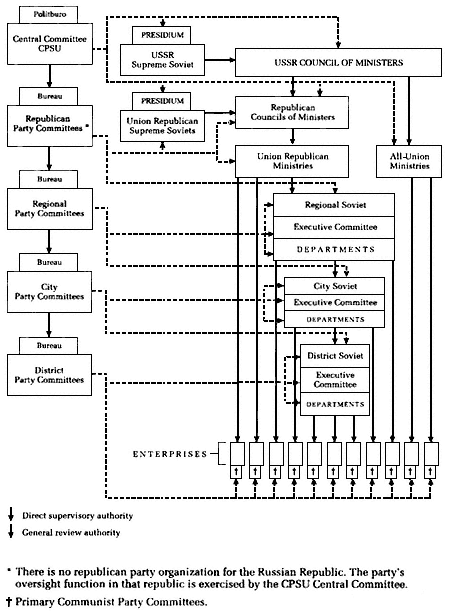The Place of the Party
Local institutions in the Soviet Union are also subject to a dual system of political subordination: that within the state system of ministries and soviets, and that within a parallel network of party agencies.[29] This system of subordination and supervision is represented in Chart 2: the solid lines show the flow of direct administrative authority within the state bureaucracy; the dotted lines highlight the flow of party review over state institutions at various administrative levels. The broadly political and ideological obligations established by the party for state bodies are imposed on soviet municipal leaders and institutions and have few if any counterparts in the West.
The Communist Party constitutes a network designed to coordinate the establishment of policy that is to be implemented by the state.

Chart 2.
System of party/state dual subordination.
There is no republican party organization for the Russian Republic. The party's oversight function in that republic is exercised by the CPSU Central Committee.
Primary Communist Party Committees.
The state bureaucracy, in turn, is intended to coordinate policy implementation. The end result is a bureaucratic structure that at first glance appears needlessly complex but can actually function as a rather streamlined and wholly integrated system. Anatomically, government and party organizations at any given level of this total administrative matrix are equivalent; in daily practice, the Communist Party dominates the entire system.
At the local level, municipal party institutions (the dotted lines in Chart 2) assume responsibility for general supervision and coordination of all economic, social, political, and cultural activities within their jurisdiction. Unlike the local soviets, which have an administrative role, local party committees supervise the commanding policy heights of management, leaving the soviets to wrestle with details.
Party supervision of local state institutions takes three primary forms. The first is the least formal: party members within state institutions are required to adhere to principles of party discipline by working to implement party policies. Whenever there are more than three party members within a given institution, those members are to form a party group that monitors the implementation of party pronouncements.[30] During the early 1980s, for example, there were over 21,000 such party groups throughout the Leningrad region.[31] In this manner state institutions become inexorably tied to their party equivalent through an invisible net of crosscutting membership ties.
The second mode of party supervision is the most formal and visible. State bodies officially cooperate with their party equivalent, and both sets of institutions prepare fully integrated plans of action.[32] Equivalent party and state institutions frequently have interlocking and overlapping executive councils. Moreover, as is illustrated in Chart 2, they have parallel organizational structures, with party committees exercising superior authority over partner state bodies (see once again the dotted lines in the chart). In Leningrad, for example, the regional party committee elects a bureau parallel to the regional soviet executive committee and operates sixteen departments parallel to the regional soviet executive committee's thirty-nine departments and administrations.[33] The Leningrad city party committee, for its part, similarly elects a bureau with a dozen members and operates twelve departments, while the city soviet's executive committee has established some forty-one departments and administrations.[34] The smaller number of party departments reflects their more general policy and supervisory mission, while the larger number of soviet departments and administrations illustrates a penchant among state agencies for more circumscribed bureaucratic vigilance.
The third form of party supervision, which is neither formal nor particularly visible, has become the subject of intense scrutiny by Western political scientists. We speak here of the integrated system of per-
sonnel appointment known as the Communist Party's nomenklatura , whereby higher-ranking party and state institutions are responsible for the personnel placement of cadres in subordinate organizations. This pattern is repeated throughout the state and party hierarchies up to careers that fall within the domain of the most senior nomenklatura agency of all, the Central Committee of the Communist Party.[35]